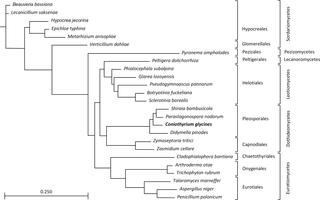PLOS ONE ( IF 2.9 ) Pub Date : 2018-11-07 , DOI: 10.1371/journal.pone.0207062 Christine L Stone 1 , Reid D Frederick 1 , Paul W Tooley 1 , Douglas G Luster 1 , Brittany Campos 2 , Richard A Winegar 2 , Ulrich Melcher 3 , Jacqueline Fletcher 4 , Trenna Blagden 4

|
Coniothyrium glycines, the causal agent of soybean red leaf blotch, is a USDA APHIS-listed Plant Pathogen Select Agent and potential threat to US agriculture. Sequencing of the C. glycines mt genome revealed a circular 98,533-bp molecule with a mean GC content of 29.01%. It contains twelve of the mitochondrial genes typically involved in oxidative phosphorylation (atp6, cob, cox1-3, nad1-6, and nad4L), one for a ribosomal protein (rps3), four for hypothetical proteins, one for each of the small and large subunit ribosomal RNAs (rns and rnl) and a set of 30 tRNAs. Genes were encoded on both DNA strands with cox1 and cox2 occurring as adjacent genes having no intergenic spacers. Likewise, nad2 and nad3 are adjacent with no intergenic spacers and nad5 is immediately followed by nad4L with an overlap of one base. Thirty-two introns, comprising 54.1% of the total mt genome, were identified within eight protein-coding genes and the rnl. Eighteen of the introns contained putative intronic ORFs with either LAGLIDADG or GIY-YIG homing endonuclease motifs, and an additional eleven introns showed evidence of truncated or degenerate endonuclease motifs. One intron possessed a degenerate N-acetyl-transferase domain. C. glycines shares some conservation of gene order with other members of the Pleosporales, most notably nad6-rnl-atp6 and associated conserved tRNA clusters. Phylogenetic analysis of the twelve shared protein coding genes agrees with commonly accepted fungal taxonomy. C. glycines represents the second largest mt genome from a member of the Pleosporales sequenced to date. This research provides the first genomic information on C. glycines, which may provide targets for rapid diagnostic assays and population studies.
中文翻译:

对大豆红叶斑病病原菌 Coniothyrium sweetines 线粒体基因组的注释和分析揭示了丰富的归巢核酸内切酶
大豆红叶斑病的病原菌是美国农业部动植物检疫局 (USDA APHIS) 列出的植物病原体选择剂,对美国农业构成潜在威胁。 C的测序。甘氨酸mt 基因组揭示了一个 98,533 bp 的环状分子,平均 GC 含量为 29.01%。它包含十二个通常参与氧化磷酸化的线粒体基因( atp 6、 cob 、 cox 1-3、 nad 1-6 和nad 4L),一个用于核糖体蛋白 ( rps 3),四个用于假设蛋白,一个用于假设蛋白。每个小亚基和大亚基核糖体 RNA( rns和rnl )以及一组 30 个 tRNA。基因在两条 DNA 链上编码,其中cox1和cox2作为相邻基因出现,没有基因间间隔区。同样, nad2和nad3相邻,没有基因间间隔区, nad5后面紧跟着nad4L ,有一个碱基重叠。在 8 个蛋白质编码基因和rnl中鉴定出 32 个内含子,占总 mt 基因组的 54.1%。其中 18 个内含子包含具有 LAGLIDADG 或 GIY-YIG 归巢核酸内切酶基序的推定内含子 ORF,另外 11 个内含子显示出截短或简并核酸内切酶基序的证据。一个内含子具有简并的 N-乙酰基转移酶结构域。 C 。甘氨酸与 Pleosporales 的其他成员共享一些基因顺序保守性,最显着的是nad 6- rnl - atp 6 和相关的保守 tRNA 簇。 十二个共享蛋白质编码基因的系统发育分析与普遍接受的真菌分类学一致。 C 。甘氨酸代表了迄今为止测序的 Pleosporales 成员的第二大 mt 基因组。这项研究提供了第一个关于C 的基因组信息。甘氨酸,它可以为快速诊断分析和群体研究提供靶标。


















































 京公网安备 11010802027423号
京公网安备 11010802027423号